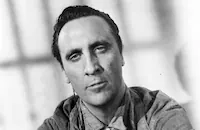A tough, no-nonsense prison movie, Revolt in the Big House (1958) is essentially a B film elevated by the talent involved. Perennial tough guy Gene Evans plays a perennial criminal who is finally convicted and sentenced to 20 years at a maximum-security prison. He immediately proceeds to establish himself at the top of the inmate pecking order and plans a breakout that includes conning his young, innocent cellmate (Robert Blake) to go along with the scheme. Also in the cast are Timothy Carey as an entertainingly unhinged convict, veteran character actor John Qualen as a wise old “lifer” and Emile Meyer as the warden, a part he had also played in Allied Artists’ earlier, more famous prison film, Riot in Cell Block 11 (1954).
Directed by R. G. Springsteen, the film was shot partly on location at California’s Folsom State Prison during the summer of 1958. Springsteen had long been a prolific director at Republic Studios, where he had recently directed the touching and underrated Come Next Spring (1956). Revolt was the second of a series of films he directed at Allied Artists.
The screenplay was originally credited to Daniel Hyatt and Eugène Lourié. “Daniel Hyatt” was actually blacklisted Daniel James; in 1998, the Writers Guild of America reinstated his correct name.
Lourié was a fascinating artist in film history. Born in Russia, he started his career in France as an art director and production designer, collaborating with director Jean Renoir in the 1930s on several important films. He later worked with Charlie Chaplin and Sam Fuller, and, in the 1950s and ’60s, expanded his skills to special effects, writing and directing. For a time, he specialized in sci-fi monster classics, directing The Beast From 20,000 Fathoms (1953) and The Giant Behemoth (1959), both of which he also wrote with Daniel James.
Revolt in the Big House opened in November 1958 and drew a strong review from Variety, which deemed the film “a well-concocted prison story, ...more impressive than its budget.... A strong second-feature entry for most markets.” The trade review also praised Timothy Carey as “excellent” and noted 24-year-old Robert Blake’s “sensitive, fiery performance... As a young Mexican boy caught in prison circumstance, Blake should earn for himself a deserved reputation as a natural.”
























